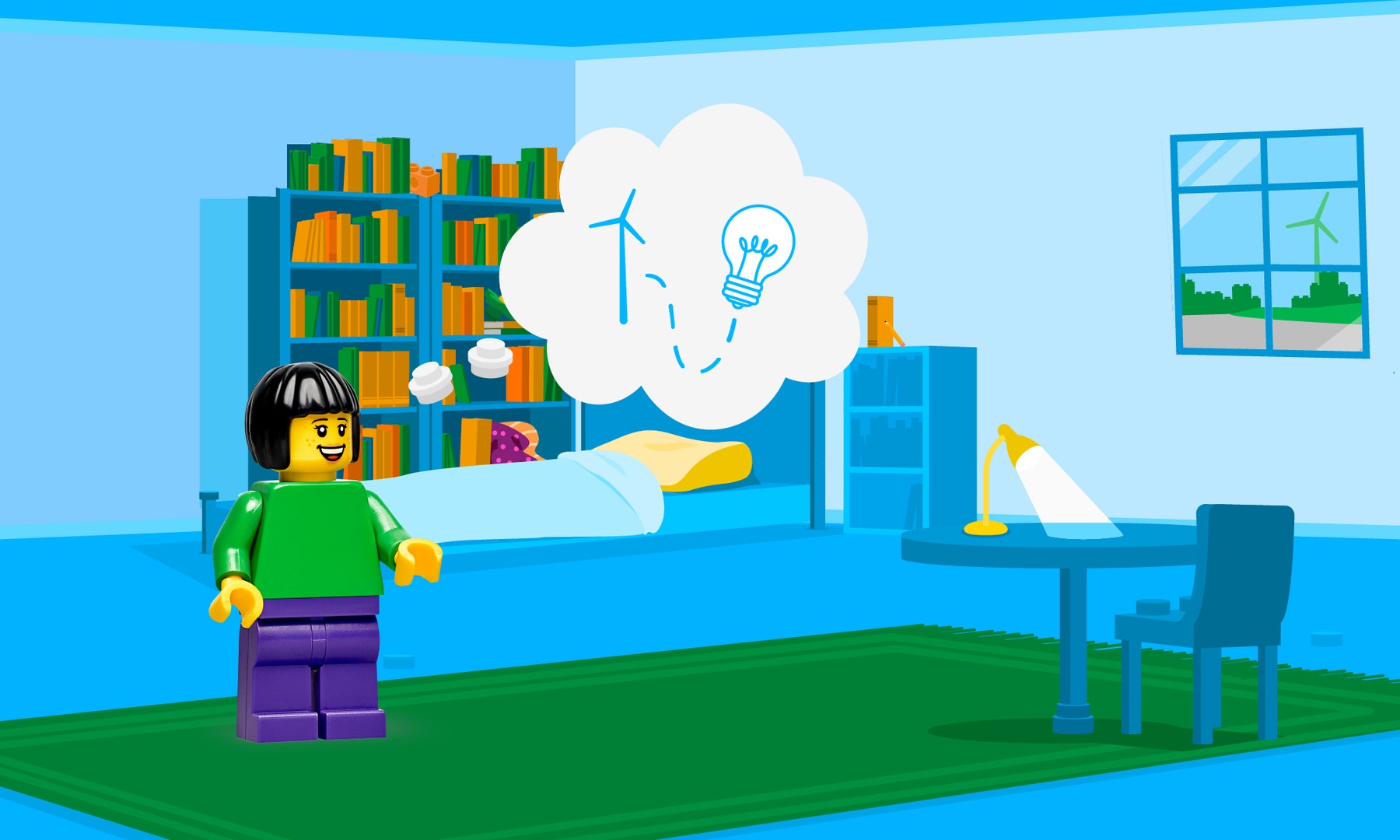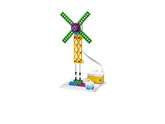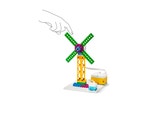Energy Resources
Sofie finds a wind turbine. She wonders how it gets energy. What are other ways to get energy from nature to use again and again?

Prepare
(NOTE: This lesson contains a Part A and a Part B. Both are important to access the full learning of the standard. If time is limited, review both parts to choose elements that meet your students’ needs.)
In this lesson, the key learning is through research about energy resources. Building a model of one type of renewable energy resource offers a way for students to show their learning. Encourage students to use the wind turbine example for inspiration and then to design and build it or another renewable resource of their choice.
- Science Background - Energy Resources:
- In this lesson, the model mimics how a wind turbine converts wind energy into electricity when the turbine’s blades turn.
- The light matrix represents how electricity is generated by the rotating blades.
- A windmill, which may be more familiar to students, converts wind into rotational energy (turning to grind flour, for example), but does not produce electricity.
- Build Prior Knowledge - Energy Resources: Using your core science materials, share information, images, and definitions.
- Review what students know about renewable and non-renewable energy resources and about how getting and using these can affect the environment. Students will learn more about the topic through this research activity.
- A wind turbine converts the energy from the wind into electricity. A windmill uses wind energy to turn machines that pump water or make flour.
- Key vocabulary: renewable energy resource, non-renewable energy resource, fossil fuel, wind turbine, environment
- Building and Programming Experience: Review the suggestions in the Unit Plan. For this lesson, you may also want to
- Reinforce with the Motor and Light tutorials in the SPIKE App Start menu.
- Use the Event, Light, and Motor Blocks sections of the Help>Word Blocks menu in the SPIKE App to provide more support.
- Use the provided white USB cable to connect hubs and devices to make the program more stable. This will enable students to better see the data that show how the speed of the blades affects the light’s brightness and how this is similar to a turbine creating less or more electricity from wind.
- Materials: Locate images of windmills and wind turbines in order to distinguish these for students. Locate age-appropriate suitable research resources about renewable and non-renewable resources (e.g., solar, wind, nuclear, and fossil fuels), human uses of these, and their environmental impacts. Consider how to integrate the resources in the lesson.
PART A (45 minutes)
Engage
(Whole Class, 10 minutes)

Introduce the story’s main character(s) and the first challenge: Sofie finds a wind turbine. She wonders how it gets energy. What are other ways to get energy to use again and again?
THINK—Facilitate a brief discussion about the lesson topic(s), using the story picture if you wish.
- What kind of energy resource is wind? Why? (Wind is a renewable resource; there is always more wind.)
- What makes energy renewable? Give some examples. (We can make or get more because nature replenishes it; wind energy, flowing water in rivers, sunlight.)
- What makes energy non-renewable? Give some examples. (It can be used up, with no way to get more; examples include fossil fuels like oil, natural gas, and coal and materials like uranium for nuclear energy.)
- How does using different kinds of energy change the environment? (Building dams replaces animal habitats, mining can destroy the surface of land, burning fossil fuels causes air pollution.)
Distribute a SPIKE™ Essential Set and a device to each group.
Explore
(Small Groups, 25 minutes)
As students work, consider sharing the examples below, clarifying that they show a model of/program for a wind turbine that uses wind energy to generate electricity. Students may build a turbine or another chosen renewable energy resource.
Have students:
- Use at least two sources to research both renewable and non-renewable energy resources, including how people use the resources and how this affects the environment. (Review classroom best practices for research.)
- Choose one renewable resource.
- Begin to BUILD and PROGRAM a model of one energy renewable resource to show their learning.
Facilitate brainstorming about using LEGO® elements in their models. For the wind turbine, this might include using long pieces as fan blades or programming the light matrix to come on when the blades are turned by hand. Students use their hands to spin the blades and can spin them faster or slower to see different outcomes from the matrix light.
Example Ideas
.png?locale=en-us&auto=webp&format=jpeg&width=216&height=124&quality=90&fit=bounds)
.png?locale=en-us&auto=webp&format=jpeg&width=216&height=124&quality=90&fit=bounds)



Explain
(Whole Class, 10 minutes)
Gather students for sharing.
Have each group use their progress model to demonstrate and explain:
- How it shows a renewable energy resource.
- How people use this type of energy resource.
- Positive and negative ways that using their chosen renewable resource affects the environment compared with non-renewable resources.
Elicit sharing about students’ progress and encourage students to use inspiration from shared ideas.
If you wish to continue in Part B—Explain, have students keep their models intact or allow time for rebuilding.
PART B (45 minutes)
Explain
(Whole Class, 10 minutes)
- Repeat the steps from Part A—Explain to support additional sharing, brainstorming, and inspiration for continued model building.
Elaborate
(Whole Class, 30 minutes)
Have students:
- (15 min) Continue to BUILD and PROGRAM their model of a renewable energy resource like wind.
- (10 min) Use their completed models to share and exchange learning about renewable and non-renewable energy resources.
(5 min) Invite students to share knowledge, ideas, or skills that
- Helped them complete the challenge.
- They learned while doing research and designing their models.
Have students clean up the sets and work areas.
Evaluate
(Whole Class, 5 minutes)
- Ask guiding questions to elicit students’ thinking and their decisions while ideating, building, and programming.
Observation Checklist
Review the learning objectives (Teacher Support box).
Share specific student responses and behaviors at different levels of mastery.
Use the checklist to observe students’ progress:
- They choose at least two sources for research.
- They accurately describe renewable and non-renewable energy resources.
- They accurately explain where their energy resource comes from and how people use it.
- They describe some positive and negative effects on the environment caused by getting and using their chosen renewable energy resource vs. non-renewable resources.
- They build and program an accurate model of their chosen renewable energy resource.
Self-Assessment
Have each student choose the brick that they feel best represents their performance。
- Blue brick: I think I can follow instructions to create a program.
- Yellow brick: I can follow instructions to create a program.
- Green brick: I can follow instructions to create a program, and I can help a friend do it too.
Peer-Feedback
In their small groups, have your students discuss their experiences working together.
Encourage them to use statements like these:
- I liked it when you…
- I’d like to hear more about how you…
Differentiation
Simplify this lesson by:
- Reducing the research task to a limited list of renewable and non-renewable energy resources.
Increase the difficulty by:
- Having students increase the complexity of their model. For the turbine, this could include changing the color of the light based on the direction the blade turns, e.g., red when the blades turn left and blue when they turn right. They can also program the blades to move at different speeds to simulate various wind speeds.
Extension
Have students research ways in which humans can reduce the negative impacts of using renewable and/or non-renewable energy resources on the environment. Have them share their findings through a brief video or written document of their choosing.
If facilitated, this will extend beyond the 45-minute lesson.
Language Arts: CCSS.ELA-LITERACY.W.4.7
Teacher Support
Students will:
- Use research to explain how humans use renewable and non-renewable energy resources from nature.
- Use research to describe the positive and negative effects on the environment of using renewable vs. non-renewable resources.
- Build a model to show one renewable energy resource.
(one for every two students)
- LEGO® Education SPIKE™ Essential Set
- Device with the LEGO Education SPIKE App installed
- See Prepare - Materials
Meet the team: Minifigure Bios
- NGSS 4-ESS3-1: Obtain and combine information to describe that energy and fuels are derived from natural resources and that their uses affect the environment.
- NGSS 3-5-EST1-1
- CSTA 1B-AP-15
- ISTE 1.4.c
- CCSS.ELA. LITERACY.SL4.1
- CCSS.MATH. CONTENT.4.MD.A.1
Language Arts Extension
- CCSS. ELA-LITERACY.W.4.7